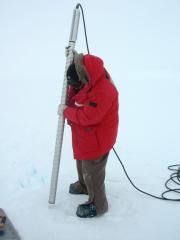Ice Cores
Ice cores are cores about 10 cm (4 inches) in diameter that are drilled through kilometers (miles) of ice sheets. An ice sheet is a large thick mass of glacial ice that forms from the accumulation of annual layers of snow. The air between the original snowflakes is trapped as the snow begins to accumulate. As more snow falls, the buried snow is compressed and eventually freezes. Consequently, these “air bubbles” provide a historical record of the gases and even dust particles in the atmosphere at the time the snow fell. The deepest core samples contain the oldest air.
Ice cores were first extracted from Antarctica and Greenland in 1957-1958, the International Geophysical Year. By the 1990s, the United States and Europe had drilled through the summit of Greenland's ice sheet to the bedrock to obtain about 200,000 years of climate data. And by 2008, the European Project for Ice Coring in Antarctica (EPICA) was able to reconstruct about 800,000 years of climate data. To reconstruct the air temperature from an ice core, scientists analyze the air trapped in the ice using either of two methods – the oxygen isotope ratio or the deuterium to hydrogen ratio.

